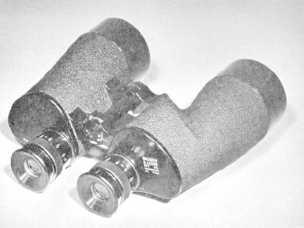| |
The 21MC, captain's command announcing
system, an approximate parallel to the JA
The 22MC, radio room announcing system, a
substitute for the JX
The 24MC, flag officer's command announcing
system, the intercom equivalent of the JF
LOOKOUTS’ EQUIPMENT
LEARNING OBJECTIVE: Explain the proper
usage and care of lookout equipment.
You were born with the most important lookout
equipment you will ever use-your own two eyes. In
lookout work, your eyes are invaluable if you use them
right. You have already learned a good deal about
proper use of the eyes in night scanning and in day
scanning. However, you still have much to learn about
scanning and the equipment you are required to operate.
The lookout on the average ship in the Navy will
have most of the following equipment:
binoculars
binocular filters
sunglasses
dark-adaptation goggles
alidades
peloruses
sound-powered phones
various articles of foul-weather gear
Although this gear may be stamped “U.S. Navy,” it
is yours while you use it. And it is up to you to know
how to use it and how to take care of it properly.
BINOCULARS
The most commonly used optical equipment is the
binoculars (fig. 2-20). Although normally only 7 power,
the binoculars gives a wide range of vision and is best
suited for searching over a wide area or for following a
swiftly moving target. The binoculars requires the use
of both eyes; but since both eyes do not always have the
same vision, it is best to adjust the focus for each lens
individually. Proper focus is essential. If the focus is off,
things look blurred, eyestrain is greatly increased, and
maximum efficiency will not be obtained.
Figure 2-20.-7 x 50 binoculars.
Before focusing the binoculars for each eye, turn
both scales to the +4 setting. Hold the binoculars firmly
against your eyebrows. To get the focus for the left eye
(only one eye can be focused at a time), cup the right
hand over the right lens, cutting out all the light to that
eye. Be sure to keep both eyes open, however, since
closing one eye will give an incorrect focus. Train the
binoculars on a small, well-defined object. Slowly turn
the eyepiece from its +4 setting until the object stands
out in sharp detail.
The reading on the scale will give you the correct
focus for your left eye. Now do the same for the right
eye. The chances are the setting will be different. You
might repeat this focusing process for each eye several
times just to make sure the focus is right.
Once you get the glasses properly focused,
remember the settings. The best reason for
remembering the settings is that it is difficult to focus
your binoculars on a very dark night. The correct night
focus is usually a -1 setting from your day focus for
each eye.
The other adjustment for binoculars is the
inter-pupillary distance (IPD) adjustment. All Navy
binoculars have the IPD scale on the hinge between the
barrels. Find out what your IPD is and remember it.
When you set your correct IPD on the scale, you will
see a single circle in focus. At night, if you have the
wrong IPD setting, light that should be going to your
eyes will be cut out.
Take a look through a pair of binoculars that is not
adjusted for your eyes and then look through a pair that
is properly adjusted. Notice the great difference. Keep
this in mind when you see the binoculars that belong to
2-19
|

